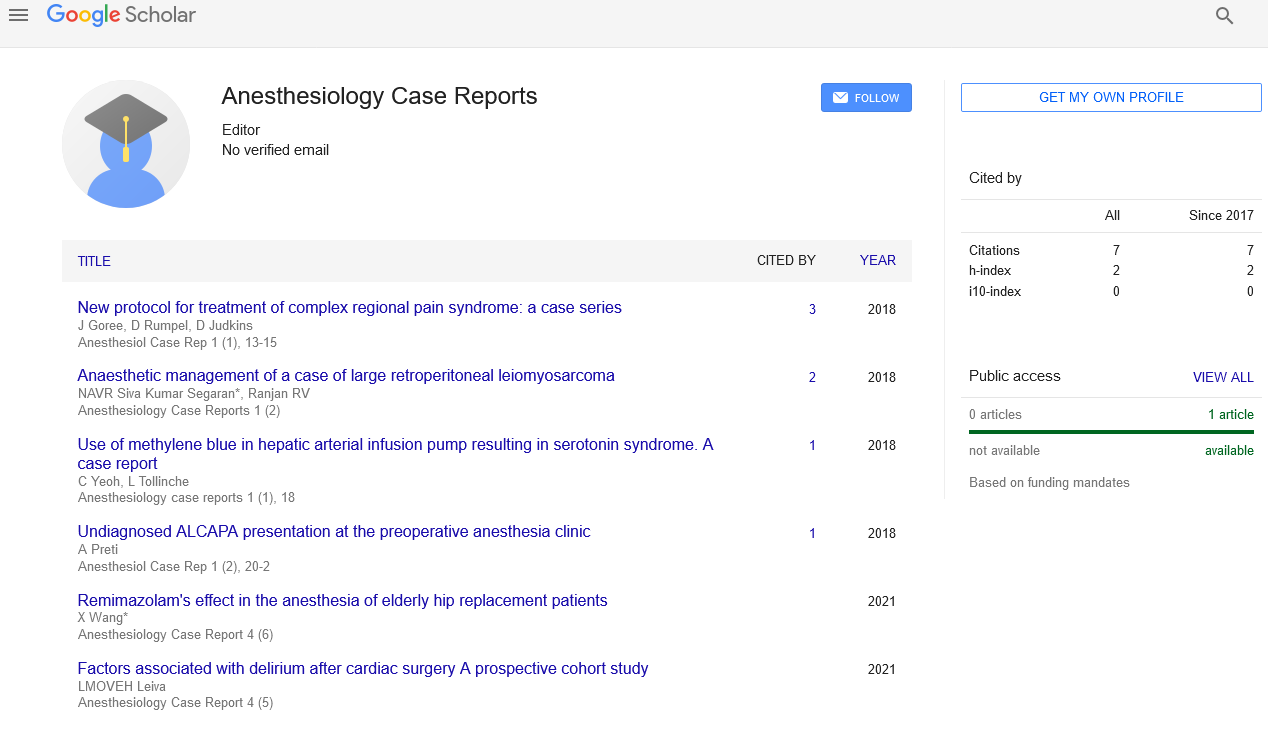Note on anesthesia and its subtypes
Received: 04-Nov-2021 Accepted Date: Nov 18, 2021; Published: 25-Dec-2021
This open-access article is distributed under the terms of the Creative Commons Attribution Non-Commercial License (CC BY-NC) (http://creativecommons.org/licenses/by-nc/4.0/), which permits reuse, distribution and reproduction of the article, provided that the original work is properly cited and the reuse is restricted to noncommercial purposes. For commercial reuse, contact reprints@pulsus.com
Editorial Note
Anesthesia is a medically induced state of controlled, temporary loss of sensation or awareness. It may include some or all of the following symptoms: analgesia (pain relief or prevention), paralysis (muscle relaxation), amnesia (loss of memory), and unconsciousness. An anaesthetized patient is one who is under the influence of anaesthetic drugs. This is a clinical treatment that prevents you from feeling pain during surgical or medical procedures. Sedatives are medications that are used to relieve pain. Different types of sedation work in different ways. Some sedative prescriptions numb specific parts of the body, while others numb the mind, in order to induce rest through more invasive surgeries, such as those inside the head, chest, or mid-region. Sedation temporarily blocks pain signals from nerves to brain focuses.
An anesthesiologist, a highly trained specialist, administers sedation and monitors you before, during, and after your medical procedure. Your consideration may also include an attending anaesthetist and other colleagues. The risks of complications during or after anaesthesia are frequently difficult to distinguish from the risks of the procedure for which anaesthesia is being administered, but they are primarily related to three factors: the patient's health, the complexity (and stress) of the procedure itself, and the anaesthetic technique. The patient's health has the greatest influence of these factors. Death, heart attack, and pulmonary embolism are all major perioperative risks, while postoperative nausea and vomiting and hospital readmission are minor risks. Some conditions, such as local anaesthetic toxicity, airway trauma, or malignant hyperthermia, can be linked to specific anaesthetics.
Anesthesiologists use a wide range of drugs in a variety of combinations to keep patients comfortable, relaxed, and pain-free during surgery or other procedures.There are three broad types of anaesthesia:
General Anesthesia: General anaesthesia is a medication that is given to you before certain medical procedures to make you sleep and keep you from feeling pain. Sedation works by interfering with nerve signals in your brain and body. It prevents your mind from preparing for torment and from recalling what happened during your medical procedure. This anaesthesia is used for more invasive surgeries or procedures involving the head, chest, or mid-region.
Local Anesthesia: A local anaesthetic is a medication that causes the sensation of pain to be absent. In contrast to a general anaesthetic, a local anaesthetic produces an absence of pain in a specific location of the body without causing loss of consciousness. Many medical procedures can now be performed safely and easily while you are awake. It is used for procedures such as performing a skin biopsy or a breast biopsy, repairing a broken bone, or sewing a deep cut. You will be aware and alarmed, and you may feel some strain, but you will not experience torment in the space being dealt with. Local anaesthesia, incidental effects, and complexities are uncommon and, in most cases, minor. For example, you may experience irritation where the prescription was infused. In rare cases, you can.
Regional Anesthesia: Regional anaesthesia relieves pain in a larger area of your body, such as an appendage or everything beneath your chest. You can remain conscious during the procedure or be sedated despite the local sedative. The drug is administered through an infusion or small cylinder known as a catheter and is used when a basic infusion of local sedative is insufficient and the patient must be conscious. Territorial sedation is extremely safe and does not include the common confusions and side effects associated with sedation and general sedation. It does, however, carry a few risks, and, importantly, it is administered and monitored by a doctor anesthesiologist.





